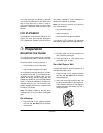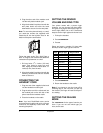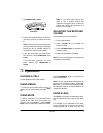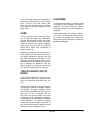
5
Operation
1. Set
TONE/PULSE
to
TONE
.
2. Pick up the handset. When you hear the
dial tone, press any number other than
0
.
Note:
If your phone system requires that
you dial an access code (
9
, for example)
before you dial an outside number, do
not press the access code number.
3.
If the dial tone stops
, you have touch-
tone service. Leave
TONE/PULSE
set to
TONE
.
If the dial tone continues
, you have
pulse service. Set
TONE/PULSE
to
PULSE
.
Note:
If you have pulse service and
want to use a special service that
requires tone signals (such as bank by
phone), see “Using Tone Services on a
Pulse Line” on Page 6.
ADJUSTING THE RECEIVER
VOLUME
Set the receiver volume as follows:
1. Pick up the handset.
2. Press
VOLUME UP
to increase the
receiver volume.
3. Press
VOLUME DOWN
to decrease the
receiver volume.
4. Return the handset to the cradle.
Note:
You can also adjust the volume during
a telephone conversation.
ˆ
Operation
PLACING A CALL
Lift the handset and dial the number.
USING REDIAL
To redial the last number dialed (up to 31
digits), pick up the handset and press
REDI-
AL
.
USING MUTE
To talk to someone in the room without the
person on the other end of the phone line
hearing your conversation, press
STORE/
MUTE
. The STORE/MUTE indicator flashes.
Press
STORE/MUTE
again to resume your
phone conversation.
Note:
You can reactivate the microphone by
pressing any functional button, except
M1
,
M2
, and
#
. You will hear three beeps through
the handset’s receiver to indicate that the mi-
crophone is working.
USING FLASH
Use
FLASH
to perform the switchhook oper-
ation for special services, such as Call Wait-
ing.
For example, if you subscribe to Call Wait-
ing, you can put your current call on hold and
answer another call on hold. You can also
TONE/PULSE










